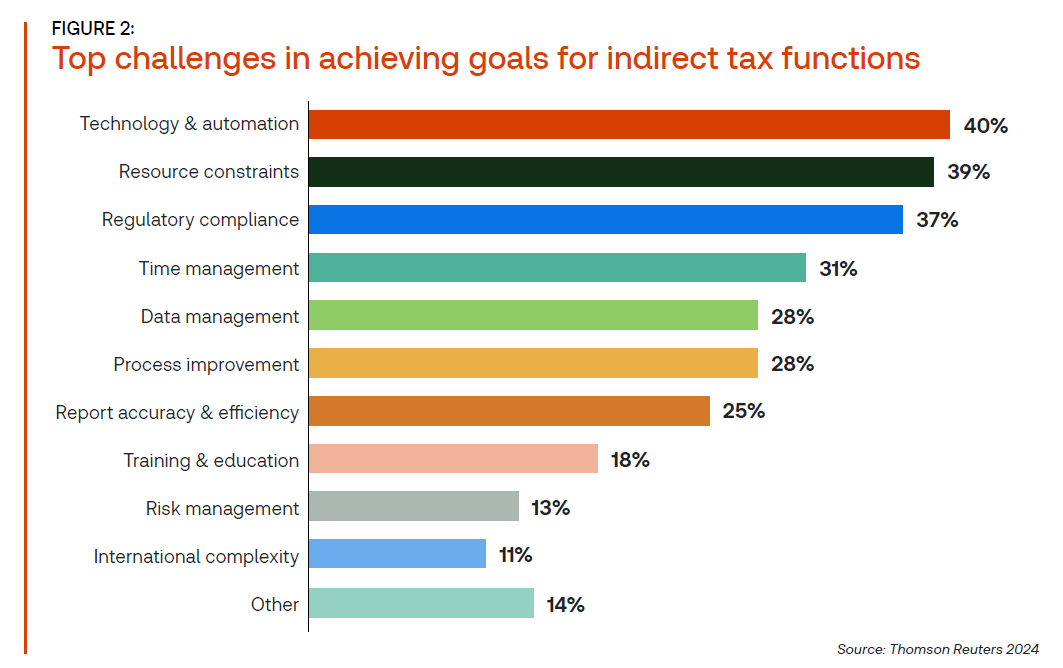Key performance indicators can drive efficiency, accountability, and strategic success in corporate tax departments, but only if they’re measured and tracked
There is a limit to the external factors that impact business professionals; however, anticipating and preparing could be the best defense. In a recent Thomson Reuters Institute report, Challenges and Changes in Indirect Tax & Compliance, corporate tax department managers expressed concerns over their continued challenges they face related to talent, changes in the regulatory environment, and the often-arduous process of adopting new technologies.
In order for these managers to develop an effective strategy to address these challenges, they must first understand their department’s status as a business unit, and in doing so there must be certain measurable data points in which productivity and basic standards of success are measured within the department.
The use of key performance indicators (KPIs) is essential for any corporate department or function, as such metrics provide a measurable framework to evaluate the unit’s performance, efficiency, and effectiveness. Corporate tax departments are no exception in that KPIs are necessary to determine how work gets done, by who, and using what methods and tools.
In the Indirect Tax & Compliance report, a plurality of respondents said their biggest impediments to achieving their goals were technology & automation, with 40% citing this as a top challenge, and resource constraints (39%). However, it is also worth noting that when asked how many KPIs were used to measure success within the department, respondents said that on average, their departments were using six, with the top three metrics being measured being the accuracy of tax filing (90%), timeliness of tax preparation (84%), and minimizing cost (64%).

It is important that tax departments have these measurements, of course; but by increasing the number of items measured, departments could more easily identify the areas in which efficiency can be gained. For example, a tax department might be able to successfully accomplish those three KPIs, however upon closer inspection, how they are getting it done could come at a greater cost — think employee burnout due to long working hours, other projects not getting done, and the list goes on.
The need for KPIs
To set themselves up for better success, tax departments should consider a few things around what they measure and why. First, does the tax department fully understand the overall business’ strategic goals? Is it clear how the tax function supports the company’s financial health and compliance objectives? After it has been determined with the best clarity what the tax function’s role is within the organization, KPIs can then be set to help track how the department is doing in relation to those strategic priorities.
Next, the heads of tax departments need to make sure that each team member understands their own role within the group and how their actions can help the group meet its own priorities. Can each employee easily identify their metrics and how it feeds into the overall department’s performance? To ensure success, department leaders should continuously monitor performance against pre-established objectives beyond just getting taxes done right and on time. When this process is done correctly, it can also provide transparency and accountability among the team and lead to better decision-making. Just as importantly, this process allows for the ability to pivot and make a different or even better decision if something isn’t working as expected.
Basing decisions on data
Using data to measure how work is done is one of the best paths toward making better decisions about how to manage a business. And KPIs can help identify inefficiencies within the department, especially around the ways in which employees work and the areas in which resources can be better deployed. They can also help determine where an increase in automation may help and what other technologies can be used to support the tax function as a efficient and effective business unit.
Going beyond tax work and regulatory compliance, tax departments can leverage this data to better provide strategy advisory services to the larger business. Having KPIs that measure the department’s performance beyond tax preparation allows department leaders to think strategically about how the department can provide additional financial insights into such as critical decision as which business activities can yield more profits or savings.
Finally, cost-saving KPIs can play a pivotal role in helping tax departments secure additional budget resources. By tracking and demonstrating efficiency through these KPIs, tax departments can provide concrete evidence of their ability to optimize resources and reduce expenses.
By highlighting successful cost-saving initiatives — such as reducing compliance costs or minimizing tax liabilities through effective planning — tax leaders can showcase their departments’ achievements and make a compelling case for more funding. These KPIs also can identify additional opportunities for cost reduction, supporting the need for investments in new technologies, training, or process automation that promise long-term savings.
Further, aligning these KPIs with the organization’s broader financial goals can demonstrate the tax department’s contribution to overall cost management and profitability. And by regularly reporting on these metrics, departments can foster trust and accountability, making it easier to justify budget increases. In this way, tax departments can present a strong, data-driven argument for the additional resources they need to enhance their efficiency and effectiveness.
Conclusion
The implementation and continuous monitoring of KPIs are necessities for the success of corporate tax departments. These metrics provide a measurable framework to evaluate performance, efficiency, and effectiveness, allowing tax departments to align their operations with the broader strategic goals of the organization.
By understanding their role within the company and setting relevant KPIs, tax departments can ensure that each team member is aware of their contributions towards meeting departmental and organizational objectives. This not only fosters accountability and transparency but also aids in identifying inefficiencies and areas in which resources can be better utilized. Moreover, KPIs can highlight the need for technological investments and automation, further enhancing the department’s efficiency.
Beyond just meeting tax filings and compliance requirements, corporate tax departments can offer strategic advisory services that contribute to their companies’ overall financial health. In essence, KPIs are a critical tool that empowers tax departments to make informed, data-driven decisions, ultimately driving their success and value within the organization.







